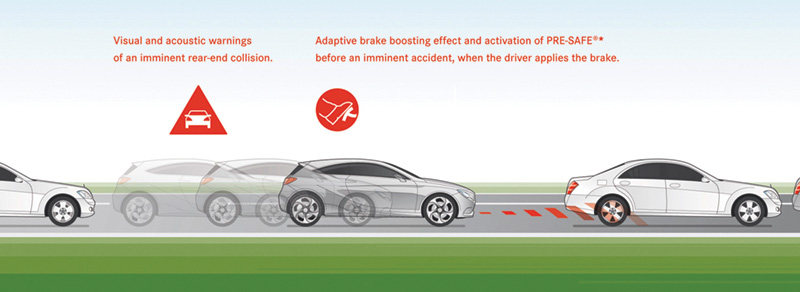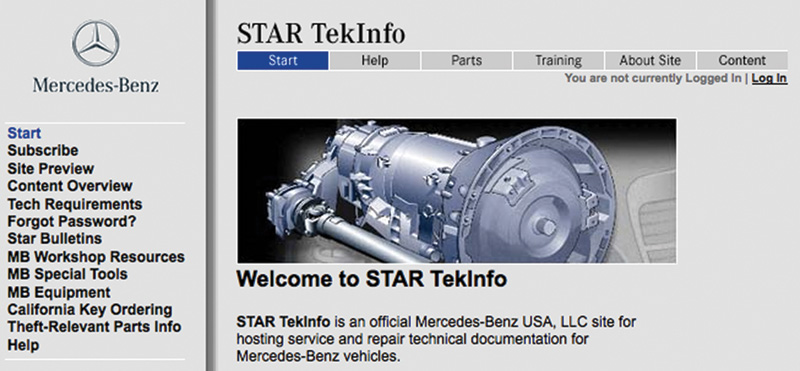Repair of integrated safety systems requires more than proper frame alignment
The best accident is one that doesn’t happen at all. Yet the reality is that accidents occur. In a perfect world, collision repair would be easy. But the pace of increasing vehicle complexity continues to ramp up, which creates both collision repair challenges and opportunities.
Much of this emergent advanced technology and innovation shows up first in Mercedes-Benz vehicles, which offers a competitive edge to the automaker’s certified collision centers. But to transform that opportunity into profitability, a facility and its staff must commit to four tenets:
- Be constantly aware of inbound change.
- Source accurate repair information.
- Follow proper repair procedures.
- Use approved tools and equipment.
Take vehicle safety systems, for example. Just as the introduction of advanced high-strength steels and alloys required collision professionals to change, new safety systems require a corresponding shift in knowledge, repair methods, tooling and competencies.
Proper frame straightening is essential for these safety systems to operate as intended post-repair. In addition, components must be properly diagnosed and repositioned during repair. Technicians must also be able to analyze safety systems to discern if reprogramming or replacement and re-initialization is needed. Clearly, your job is becoming more complicated, but that’s why customers come to you, instead of to a less well-prepared facility.
Safety is a dynamic evolutionary process
As automakers and regulators move toward a shared vision of zero traffic fatalities, innovation in vehicle safety systems has evolved. Initially “passive†safety systems (e.g. airbags, seatbelts, strong body structures) helped to reduce the effects of an accident without any interaction with the driver. Over time, “active†safety systems (e.g. brake assist, electronic stability control) emerged, which by factoring in the current state of the vehicle in milliseconds, helped to avoid or minimize the effects of an accident.
In just the past few years, “integrated†safety systems have begun to show up on many Mercedes-Benz vehicles that do just that. These emergent safety systems often employ camera-, radar- or laser-based sensors that interpret signals and leverage in-vehicle communication across many interconnected systems to help the driver to control the vehicle via audio, visual, or tactile prompting, or, if necessary, intervene directly to control the vehicle should a driver not react to a dangerous threat in time.
“Our aim is to reduce the number of serious accidents even further, and on a broad basis,†says Ulrich Mellinghoff, director of safety at Mercedes-Benz. “Following detailed analyses of accident data, we estimate that radar-based technology will be able to prevent around 20 percent of collisions, and mitigate the other effects of accidents in a further 25 percent of cases.â€
Give it to me straight
Collision technicians must know and understand, before beginning a repair, what safety systems a vehicle has, where they’re located, the correct OEM procedures for repair or replacement, what approved tools and equipment are needed, and how to test and verify that these systems are positioned and operating as designed once repairs are completed. Anything less is an erosion of the quality of the repair that risks one’s business and professional reputation, let alone customer safety.
All Mercedes-Benz certified collision repair facilities are required to use current service information, Mercedes-Benz-approved dedicated straightening equipment and associated fixtures, and to follow Mercedes-Benz work procedures using approved materials. Failure to do so may result in the decertification of the repair facility. In the event that jobs are performed as sublet repairs by other collision facilities, the dealer is responsible for providing proper service information, equipment, tools, materials, and procedures to those performing the repairs. This information is all available at www.startekinfo.com, MBUSA’s website.
Mercedes-Benz collision repair procedures are very specific concerning the type of equipment used and reconditioning of bodies following an accident. In the United States, the only companies marketing straightening equipment that is approved by Mercedes-Benz USA LLC (MBUSA) are Celette Inc. and Car Bench North America. Both work closely with MBUSA parent Daimler AG in designing and building dedicated fixture sets specifically for Mercedes-Benz and Maybach vehicles that not only allow for accurate component location, but also provide a safe, proper anchoring of the vehicle during pulling operations.
For example, Celette Inc. offers a full spectrum of equipment for frame alignment. Its lineup (with the current pricing) includes the:
NAJA Computerized Measuring System —There is no point in having an accurate measuring system if the underlying data is not accurate. NAJA is extremely accurate because it is based on actual Mercedes-Benz model blueprints.
Sevenne Bench and Pulling Unit for frame straightening. Used in conjunction with the NAJA, technicians align frames accurately and more quickly.
And assorted accessories that include an MZ Tower Set, Cross Member Set, and more.
Safety walks a fine line
Just like milliseconds can make the difference in mitigating or avoiding a crash, millimeters can make a difference in frame straightening. When a vehicle is in an accident that requires straightening, MBUSA’s tolerances may specify a small margin equivalent to approximately 1 millimeter, requiring precise accuracy. If the actual frame correction exceeds this margin, the frame can cause instability and lessen automotive control, a future driving hazard. Improper correction can also lead to excessive wear and tear on the vehicle’s tires and lower performance of electronic and mechanical parts, possible even resulting in some failure.
Vehicle frame integrity requires computerized measuring systems, which often use laser technology. Because these measuring systems are very accurate and enable the complete measurement of the vehicle during the repair process, technicians can make frame repairs with the certainty that repairs to one section of the vehicle don’t negatively affect other areas of the vehicle. In addition, the website provides wiring diagrams, images, location and positioning data, diagnostic reprogramming instructions and more.
Because people’s lives depend on it, the repair of a damaged vehicle requires certainty that the frame is structurally sound and properly aligned. The frame affects the accuracy and functionality of many safety systems and how a vehicle will react in a subsequent collision. Technicians must accurately measure and return the frame to pre-collision condition before attempting to rebuild the vehicle on top of it. Complete, safe collision repairs must be performed using the most current service information and correct materials, tools and procedures available. Anything short of that is irresponsible and unprofessional.
Safety system damage may not be apparent at first glance
Getting the frame measured and aligned is just the beginning of the repair process. Collision technicians must also verify the structural integrity of the upper body and passenger safety cage and ensure that all measurements are within specification because deviations may impair the performance and activation of vehicle safety systems during a subsequent collision. Here, laser measuring saves technician time.
If repairs are required for any upper body components above the frame, website service information will advise whether to pull, section, or replace certain steels. It will also denote safety system wiring schematics, the location and layout of electronic sensors and modules, and identify critical components that might be hidden from sight, but possibly be damaged indirectly during a collision.
Vehicle electronic and safety systems need to be tested after a collision to ensure they are operating as designed. Technicians who use the Mercedes-Benz factory scan tool have the most complete diagnostic and reprogramming functionality available, which is essential for new and emerging safety systems. To test safety system components after a collision, locate and disassemble them from the other damaged parts so that repair procedures to the latter do not affect safety components. If the units are still operational, they may need to be reprogrammed to return to pre-crash capability. If the safety components have to be replaced, ensure that the new parts are tested and reinitialized if necessary.
Finally, when reassembling, reference wiring diagrams to ensure that the safety system components, in particular sensors, are positioned properly. Technicians should also check other procedures. For example, when performing filling and painting work on bumpers, MBUSA procedures stipulate that where short-range radar sensors are located, the maximum paint coat thickness “… should not exceed two coats of paint (primer, color and clear).†Should the paint application be thicker, the radar sensors will detect the excessive paint coat thickness as an obstacle and react as designed, but send a false signal. If the short-range radar does not function correctly after overpainting, then the paint must be removed or the bumper must be replaced, neither of which is covered by warranty.
As Mercedes-Benz continues to hone safety, comfort and driving pleasure through a whole series of innovations, these integrated systems are being incorporated into a wider range of vehicles, including compacts and, especially overseas, sub-compacts. In other words, less-expensive models now offer a number of the safety systems that have been for the most part standard on more luxurious Mercedes-Benz vehicles. These include Intelligent Lighting System (ILS), Blind Spot Assist, Lane Keeping Assist, Attention Assist, Active Parking Assist, Linguatronic, Distronic Plus, and Pre-Safe.








0 Comments